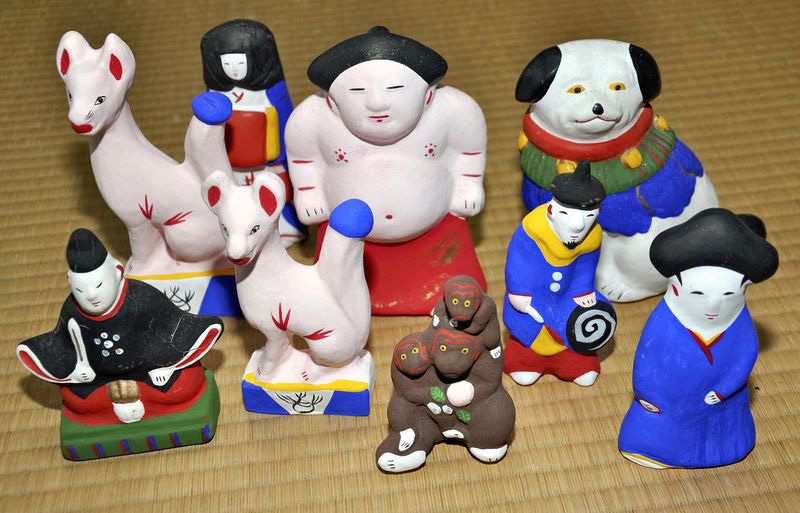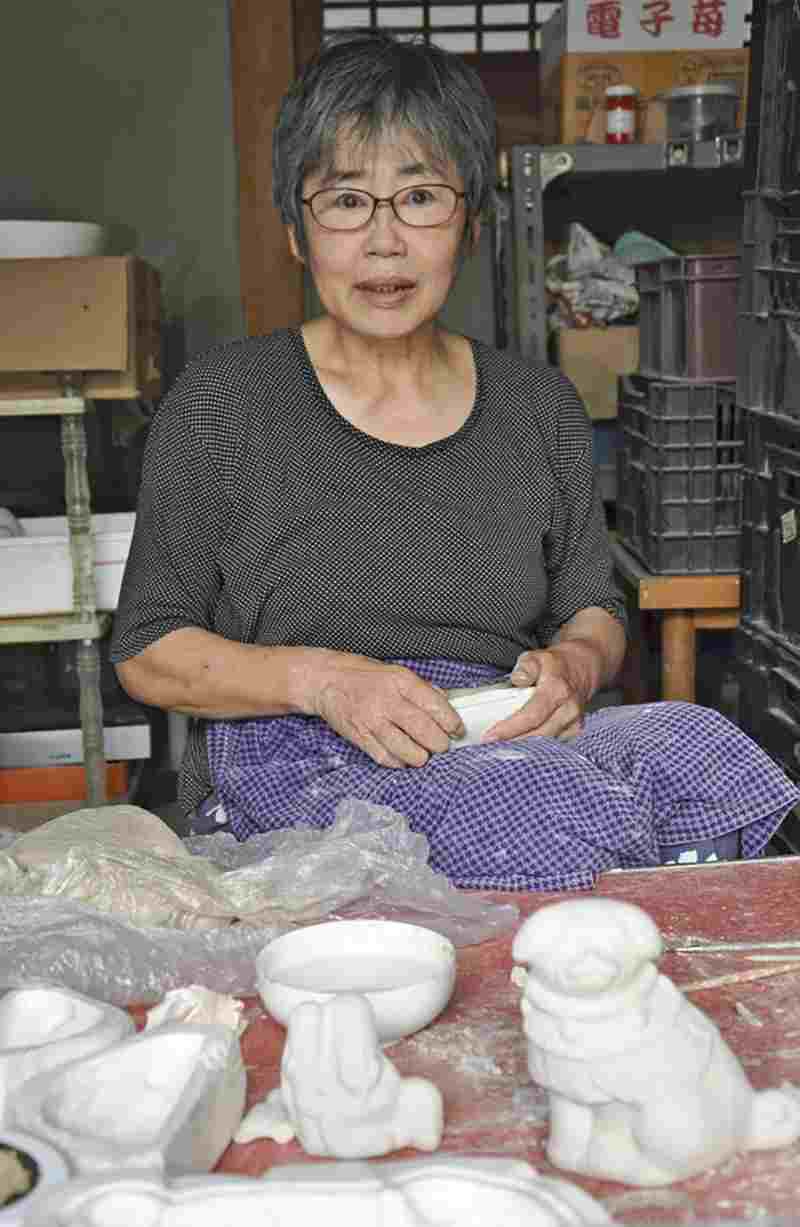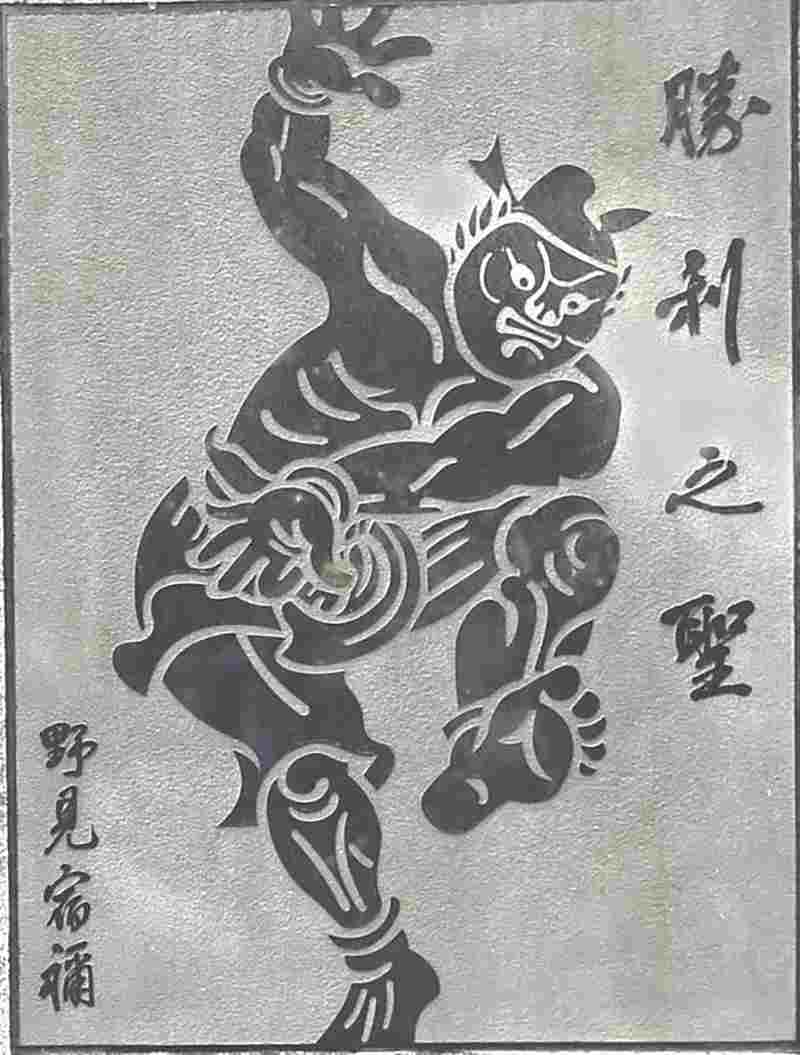Nara: Lone figurine maker carries on with creating pottery with roots in legend

Yamato Izumo clay figurines are laid out. They are known for showing simple and lovely expressions.
17:40 JST, January 3, 2022
SAKURAI, Nara — A tradition of making cute figurines that have mythological roots is being carried on by a single woman in the Izumo district of Sakurai, Nara Prefecture.
The district was a major production area for the Yamato Izumo clay figurines, which many people still appreciate. Kazu Mizuno, a 66-year-old figurine artist in the district, began making the figurines in 1973.
“It happened that when I got married, my parents-in-law were making figurines,” she said. “I was just helping out with the family business as their son’s wife. It wasn’t a matter of liking the figurines or anything like that.”
Among the clay figurines that Mizuno makes are a dog with a relaxed expression and a sumo wrestler with narrowed eyes and pursed lips — both have simple colors and shapes.

Kazu Mizuno speaks at her studio in Sakurai, Nara Prefecture.
The craft itself boasts a very long history. Legend has it that Nomi no Sukune from Izumo (present-day eastern Shimane Prefecture) suggested decorating the mausoleum of Emperor Suinin’s empress with clay figurines at her funeral, inviting many local potters to make them.
The descendants of those potters settled in Yamato (present-day Nara Prefecture) and began making the figurines. The area they lived in also became known as Izumo.
After a method of using molds was introduced from Kyoto, figurine makers began to produce a great number of items in the Edo period (1603-1867) and sold them as souvenirs on the leading lane to Hasedera temple.
The figurine making industry later declined, but Mizuno’s grandfather-in-law revived it prior to World War II.
Mizuno uses various molds in the figurine creation process, the first step of which is to fill the back and front of the molds with clay.
Then, the two molded pieces are joined together, dried in the shade and placed in a kiln to be fired with rice husks. After the clay figures are fired, the base material — a mixture of a white pigment made from shells and glue — is applied to the surface, and then the figurine is painted. It takes about a week for the whole process to be completed.

Nomi no Sukune depicted on a stone monument at Sumo Shrine in Sakurai
Mizuno uses 44 different types of molds, including those for dogs and monkeys. There are also molds for good luck figurines, for example, Hotei, one of the seven deities of good fortune; a decorated horse that brings prosperity in success and growth; and a cow carrying a bale that brings the luck of a good harvest.
There is no set of Chinese zodiac figurines, however.
“We haven’t been making zodiac figurines for a long time because we don’t have all 12 molds,” she said.
Mizuno does not use the molds that have been handed down. Rather, she uses ones that have been remade with gypsum to prevent them from wearing out.
Mizuno said that the most important thing for her is the expression of the figurines. It is hard to draw a face, whether it is of a person or a dog, because if you are distracted, your feelings will show in the products, she said.
She also emphasized the difficulty of the painting process, which cannot be done without concentrating deeply.

“At first, I thought about trying to draw something that would be cute. But then, I was struck by another desire to create something completely different,” she said. “Sometimes I feel as if I’m drawing myself at that moment rather than the expression of the figurine.”
As Mizuno is the only person making Yamato Izumo figurines, the question of how to preserve the tradition for the next generation remains. She said, however, that she is not so worried about it. If she has to stop making them, the tradition would cease to exist, but she believes that as long as there are products and materials, someone will revive it.
“I will just continue to carefully make figurines that fit the times,” she said.
The works come in sizes ranging from 10 to 40 centimeters tall, and most cost around ¥3,000. They are sold at stores such as Yuga, a local pottery and toy store in Nara City.
Founder of haniwa, sumo
Nomi no Sukune is considered to be the founder of sumo. According to Nihon Shoki, a chronicle of Japanese history completed in the 8th century, Emperor Suinin had summoned him from Izumo to make him fight against the Yamato wrestler Taima no Kehaya.
The old record said that the two had the first sumo bout watched by an emperor. Sumo Shrine, also in Sakurai, enshrines Nomi no Sukune, who is said to have won the match.
Nomi no Sukune is also regarded as the founder of haniwa, which are burial accessories for tombs of royalty or powerful families that were created in the 3rd to 6th centuries and are now called kofun. He is also said to have devised haniwa for mausoleums.
According to Nihon Shoki, there was once a custom that when a lord died, his close servants would be buried alive with him. Nomi no Sukune, who stayed in Yamato after the sumo match, advised the emperor to abolish the custom and had clay figurines set around the mausoleums in place of living humans.
Both stories have no historical basis. Not even the time when these events supposedly took place is known.
Related Tags
"Features" POPULAR ARTICLE
-

Sanrio to Open Museum in Yamanashi Pref. Dedicated to Founder, Exhibits Include Hello Kitty, Other Characters
-

Autumn Foliage Surrounds Visitors to Tokyo’s Showa Kinen Park
-

My Daughter No Longer Speaks to Me, But I Want to See Her and My Grandchild
-

Kumamoto: Public Bath Refurbished as Library Where You Can Chat, Take Photos
-

Frozen Vegetables: Demand Rises for Convenient, Tasty Domestic Produce
JN ACCESS RANKING
-

Keidanren Chairman Yoshinobu Tsutsui Visits Kashiwazaki-Kariwa Nuclear Power Plant; Inspects New Emergency Safety System
-

Imports of Rare Earths from China Facing Delays, May Be Caused by Deterioration of Japan-China Relations
-

University of Tokyo Professor Discusses Japanese Economic Security in Interview Ahead of Forum
-

Japan Pulls out of Vietnam Nuclear Project, Complicating Hanoi’s Power Plans
-

Govt Aims to Expand NISA Program Lineup, Abolish Age Restriction
























